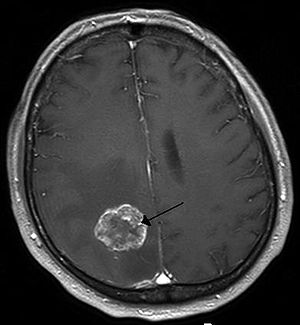Intracranial tumor
| Brain tumor | |
|---|---|
| Synonyms | Intracranial neoplasm |
 |
|
| Brain metastasis in the right cerebral hemisphere from lung cancer shown on magnetic resonance imaging. | |
| Specialty | Neurosurgery, oncology |
| Symptoms | Vary depending on the part of the brain involved, headaches, seizures, problem with vision, vomiting, mental changes |
| Types | Malignant, benign |
| Causes | Usually unknown |
| Risk factors | Neurofibromatosis, exposure to vinyl chloride, Epstein–Barr virus, ionizing radiation |
| Diagnostic method | Computed tomography, magnetic resonance imaging, tissue biopsy |
| Treatment | Surgery, radiation therapy, chemotherapy |
| Medication | Anticonvulsants, dexamethasone, furosemide |
| Prognosis | Average five-year survival rate 35% (US) |
| Frequency | 1.2 million nervous system cancers (2015) |
| Deaths | 229,000 (2015) |
| Classification | |
|---|---|
| External resources |
A brain tumor or intracranial neoplasm occurs when abnormal cells form within the brain. There are two main types of tumors: malignant or cancerous tumors and benign tumors. Cancerous tumors can be divided into primary tumors that start within the brain, and secondary tumors that have spread from somewhere else, known as brain metastasis tumors. All types of brain tumors may produce symptoms that vary depending on the part of the brain involved. These symptoms may include headaches, seizures, problem with vision, vomiting, and mental changes. The headache is classically worse in the morning and goes away with vomiting. More specific problems may include difficulty in walking, speaking, and with sensation. As the disease progresses unconsciousness may occur.
The cause of most brain tumors is unknown. Uncommon risk factors include inherited neurofibromatosis, exposure to vinyl chloride, Epstein–Barr virus, and ionizing radiation. The evidence for mobile phones is not clear. The most common types of primary tumors in adults are meningiomas (usually benign), and astrocytomas such as glioblastomas. In children, the most common type is a malignant medulloblastoma. Diagnosis is usually by medical examination along with computed tomography or magnetic resonance imaging. This is then often confirmed by a biopsy. Based on the findings, the tumors are divided into different grades of severity.
...
Wikipedia
